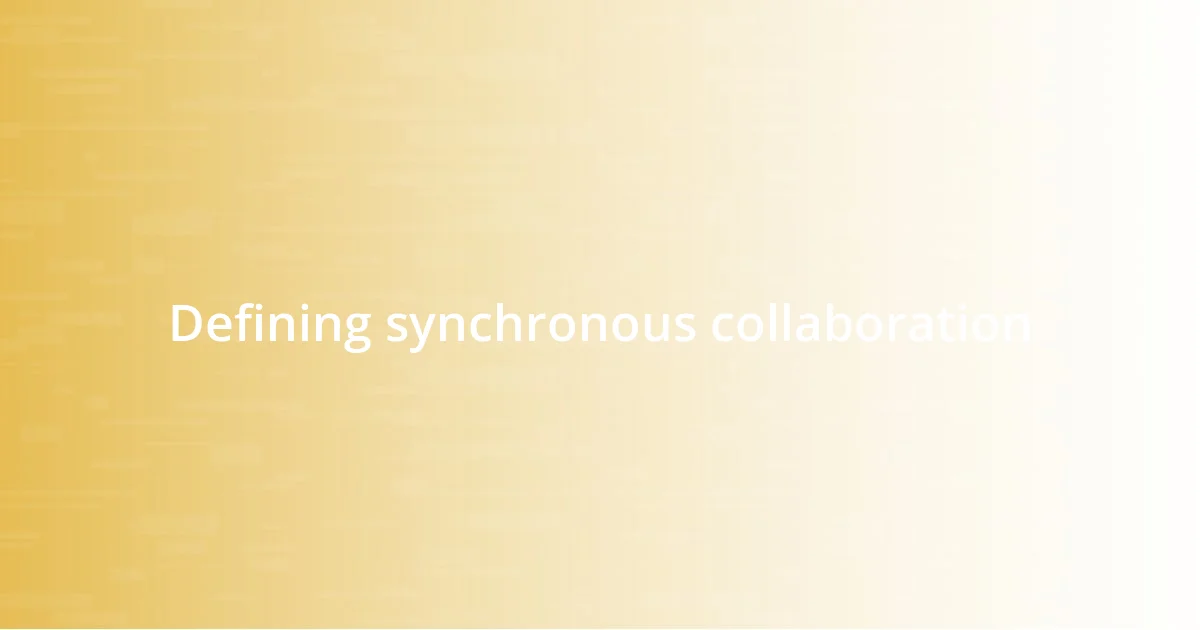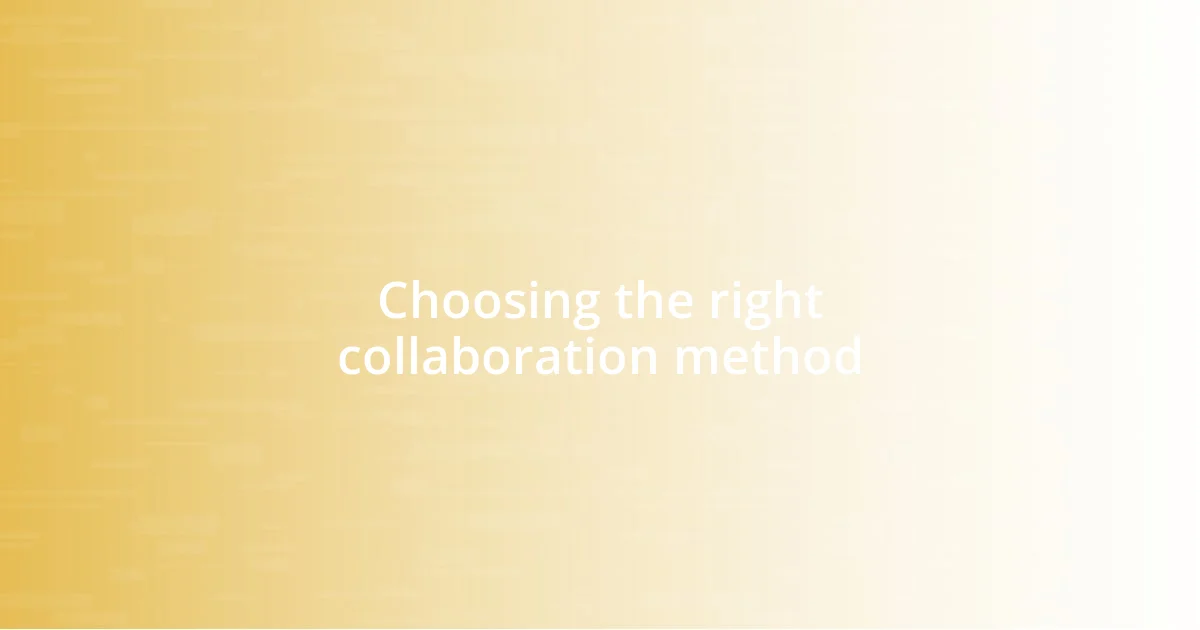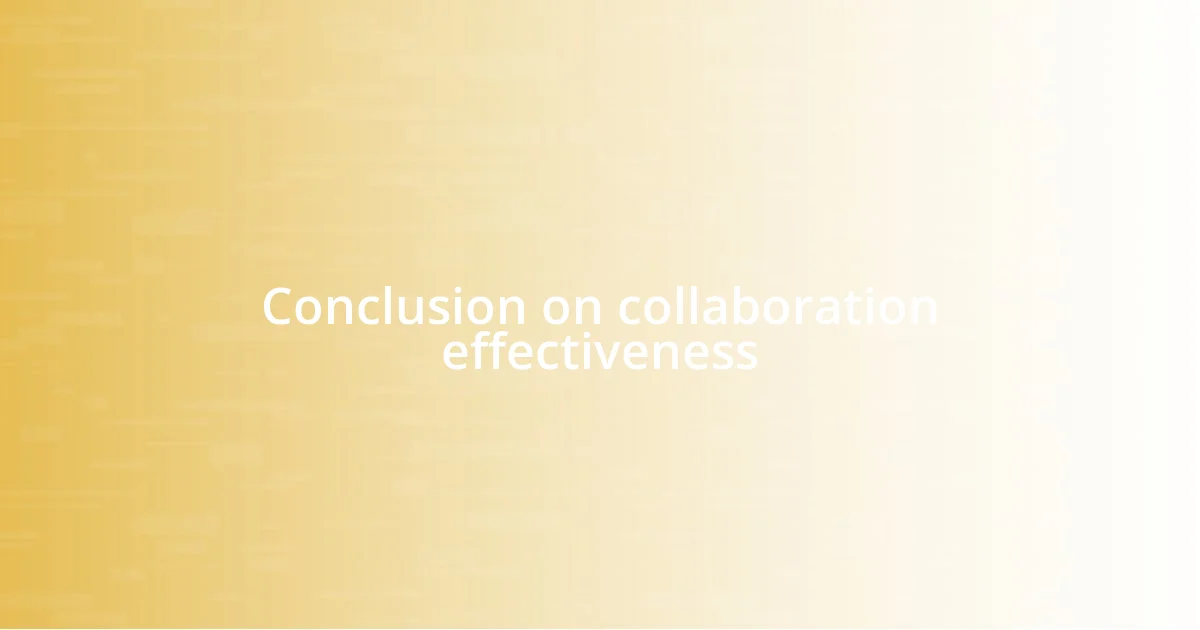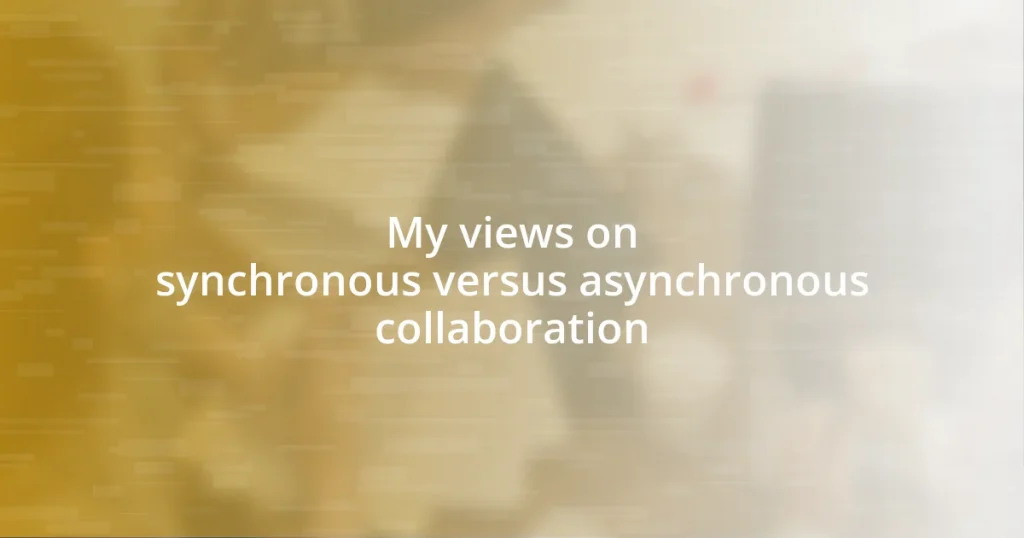Key takeaways:
- Synchronous collaboration provides immediate feedback and fosters stronger team dynamics through real-time discussions, but can overwhelm some individuals.
- Asynchronous collaboration allows for deeper reflection and inclusivity, enabling participants to articulate their thoughts without the pressure of immediate responses.
- Choosing the right collaboration method depends on task urgency and team dynamics, balancing the need for quick interaction against the benefits of thoughtful input.

Understanding collaboration methods
When I reflect on collaboration methods, I realize there’s a significant difference between synchronous and asynchronous communication. For instance, in a recent project, my team utilized a mix of both. During our live meetings, the energy was electric, allowing us to bounce ideas off each other in real-time; it felt rewarding to build off each other’s thoughts instantly.
In my experience, though, async collaboration often becomes my favorite tool for deeper thinking. I recall a time when I had to contribute to a project proposal over a week. Instead of rushing to formulate ideas in a live setting, I took my time to gather resources and respond thoughtfully to my teammates’ inputs through a shared document. It really made me value the depth you can achieve when you take a moment to reflect.
Have you ever found yourself overwhelmed in a synchronous meeting, wishing you could mull over the ideas shared? I have. That’s when I realized that asynchronous methods, such as emails or collaborative platforms, provide a space for thoughtful debate without the pressure of immediate responses. Embracing both collaboration types enhances creativity and allows for a balance between quick exchanges and deep reflection.

Defining synchronous collaboration
Synchronous collaboration occurs when team members interact in real-time, allowing for immediate feedback and discussion. Think of it as a lively brainstorming session where everyone can voice their thoughts simultaneously. I remember one time during a project sprint; we gathered in a conference room, ideas flying around the table like sparks. It was exhilarating to witness different perspectives converge instantly, leading to breakthroughs we wouldn’t have achieved through slower communication.
The beauty of synchronous collaboration lies in its immediacy. You can read the room and gauge reactions, which adds an emotional layer to discussions. I felt it vividly when we faced a tight deadline, and our team rallied together for a series of hot seat meetings. The intensity pushed us, yet the shared atmosphere made us feel like we were in it together. It created a bond that fueled our efficiency.
Despite its advantages, synchronous collaboration can also present challenges. I’ve often left meetings wondering if every voice had truly been heard amidst the whirlwind of conversation. It’s crucial, in my view, to foster an environment where everyone feels comfortable sharing their ideas without interruptions. This balance can lead to a more inclusive and productive exchange.
| Synchronous Collaboration | Characteristics |
|---|---|
| Definition | Real-time interaction |
| Examples | Video calls, in-person meetings |
| Advantages | Immediate feedback, stronger team dynamics |
| Challenges | Overwhelming for introverts, potential for side conversations |

Benefits of synchronous collaboration
Synchronous collaboration offers several key benefits that can significantly enhance teamwork. One of the most striking advantages is the immediacy of feedback. I’ve experienced moments in live discussions where I could pose a question and receive responses almost instantaneously. This dynamic not only reduces misunderstandings but also fosters a sense of urgency that can drive projects forward swiftly.
- Real-time problem-solving: Issues can be addressed as they arise, rather than lingering for days.
- Enhanced creativity: The spontaneous exchange of ideas often sparks unique solutions that might not emerge in a more structured format.
- Strong team rapport: Collaborative environments promote bonding among team members, creating a sense of camaraderie and shared purpose.
There’s also something to be said about the emotional connectivity achieved through synchronous meetings. I recall a team call where we celebrated a significant milestone. The exhilaration in our voices and shared laughter created an atmosphere of accomplishment that an email chain could never replicate. These emotional highs boost morale and motivate team members to engage by fostering a sense of belonging and collective success.
- Instant connection: Body language and vocal tone add a layer of richness to communication.
- Prompt clarifications: Questions can be asked and answered on the spot, minimizing confusion.
- Shared energy: The excitement of real-time collaboration can motivate and inspire everyone involved.

Defining asynchronous collaboration
Asynchronous collaboration refers to the exchange of ideas and feedback without the need for real-time interaction. Imagine sending a message to a colleague and awaiting their reply at their convenience. I’ve found this method not only suits my schedule but also allows deeper reflection on the topics discussed, as I can take my time to formulate responses rather than feeling rushed.
One of the most striking features of asynchronous collaboration is the flexibility it offers. I once worked on a project where team members were scattered across different time zones. This setup taught me the value of thinking through my points and articulating them clearly, knowing my colleagues would reflect on them when they logged in. It was enlightening to see how each person brought their unique perspectives to the discussion after having had time to consider the ideas presented.
Moreover, asynchronous collaboration fosters inclusivity, as it often levels the playing field for team members who might hesitate to voice their thoughts in real-time settings. I recall a particular project where a quieter team member shared their thoughtful analysis in a group chat after a meeting. It struck me how their insights, which might have been lost in the fast-paced chatter of a synchronous call, added significant depth to our strategy. Isn’t it fascinating how waiting allows for better consideration and richer contributions?

Advantages of asynchronous collaboration
Asynchronous collaboration comes with the invaluable advantage of time for thought. I vividly remember a project wherein I was developing a strategic proposal. Instead of rushing through ideas during a live meeting, I had a few days to gather feedback from my colleagues. This allowed me to absorb their perspectives and essentially refine my thoughts into a more coherent and compelling presentation. How often do we wish we had just a little more time to think things through?
Another benefit lies in the documentation created during the process. Every interaction in an asynchronous format—whether it’s emails, comments on documents, or messages in a chat—becomes a record of ideas and decisions. I’ve been part of projects where digging back into these conversations illuminated past decisions and rationales, helping us avoid redundancy and misunderstandings later on. Doesn’t it feel reassuring to have a clear trail of communication to reference?
Lastly, asynchronous collaboration encourages self-paced learning. In a recent instance, I tackled a complex issue on my own, diving into research and resources at my own speed to draft thoughtful responses. I found this not only led to richer insights but also built my confidence in expressing my viewpoints. When you can engage with content and ideas on your own terms, isn’t it intriguing how much more you can discover about both the subject and yourself?

Choosing the right collaboration method
Choosing the right collaboration method often boils down to understanding the dynamics of your team and project needs. For instance, I once faced a tight deadline on a group presentation. In that instance, real-time brainstorming sessions proved invaluable; they shattered the barrier of delays and drew immediate insights from everyone’s expertise. The thrill of ideas flowing freely was electrifying, but it made me realize how essential it is to weigh the urgency of the task against the team’s availability.
Then, there were times when I led more complex projects that spanned several weeks. I opted for asynchronous methods, allowing my teammates to engage with my proposals on their schedule. I remember hitting “send” on a detailed document, eagerly awaiting feedback. The responses I received were richer and more thoughtful than I’d anticipated, with my colleagues clearly having had time to digest and ponder over the content. Isn’t it remarkable how the right timing can enhance the quality of collaboration?
Ultimately, assessing the right method requires asking the right questions. Are your team members comfortable speaking in real-time, or do they thrive on reflective thought? I always consider the personalities involved. In one project, a particularly introverted colleague expressed a preference for written communication. Their contributions in writing turned out to be some of the most profound reflections we received. How often do we overlook the unique preferences in our teams that could lead to more impactful collaboration?

Conclusion on collaboration effectiveness
Reflecting on the effectiveness of collaboration, I’ve realized that both synchronous and asynchronous methods have their unique strengths and challenges. There was a time when a real-time brainstorming session lit a fire of creativity within my team, pushing us to think outside the box. But I’ve also experienced the quiet power of asynchronous discussions, where carefully crafted messages led to revelations I hadn’t anticipated. It makes me think: can creativity thrive without the immediacy of a live interaction?
As I consider the effectiveness of these collaboration methods, the key lies in the nature of the task and the dynamics of the team. I recall a software project where urgent deadlines required immediate feedback; the energy of real-time discussions propelled us forward rapidly. Yet, I’ve also seen how the ability to reflect before responding can yield deeper insights and sharper analyses, especially in complex scenarios. Isn’t it fascinating to see how thoughtfully timed contributions can significantly shape outcomes?
Ultimately, I believe that the effectiveness of collaboration hinges on our adaptability to circumstances and the preferences of our teammates. Allowing the team to choose their mode of communication can cultivate an environment where everyone feels empowered to contribute. Remembering that one colleague who thrived in written formats, I often wonder: could our collaborative efforts reach new heights if we embraced the best of both worlds? It’s a journey of continual learning and experimentation.















